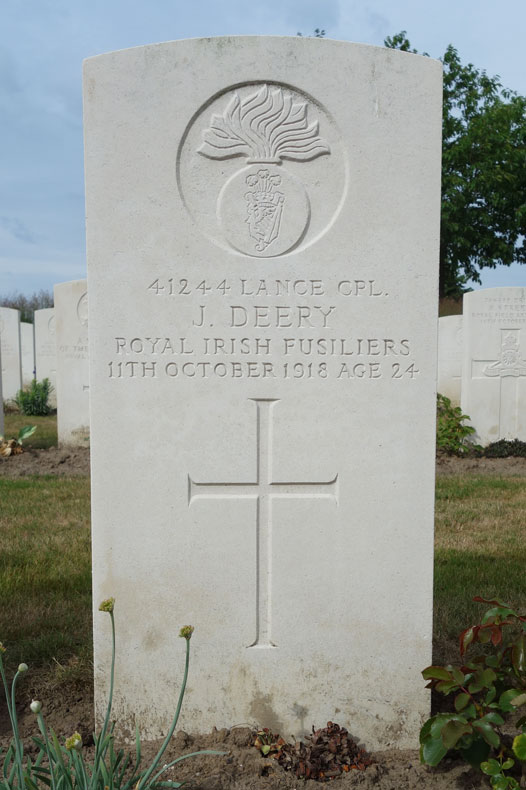![]() In memoriam
In memoriam ![]()
Lance Corporal Joseph Deery
Joseph Deery was born on 22 January 1894 at Goland, Castlederg, County Tyrone, the tenth of eleven children of farmer, later county councillor, Andrew Deery and his wife Catherine (nee Duncan). By 1911 he was boarding at a house in Pine Street, Belfast, and working as a bank clerk. Soon after he moved to Dublin, where he worked as a clerk in the Ulster Bank at College Green.
Deery enlisted in the North Irish Horse at Dublin between 2 and 6 December 1915 (No.2013). He embarked for France between 1916 and the first half of 1917, where he was posted to one of the squadrons of the 1st or 2nd North Irish Horse Regiments.
In September 1917 the 2nd Regiment was dismounted and most of its men, together with some from the 1st Regiment, were transferred to the infantry. After training at the 36th (Ulster) Division Infantry Base Depot at Harfleur, the men were formally transferred to the Royal Irish Fusiliers on 20 September and soon after were posted to the 9th (Service) Battalion – re-named the 9th (North Irish Horse) Battalion – joining it in the field at Ruyaulcourt. Deery was issued regimental number 41244 and posted to D Company.
It is likely that he saw action with the battalion in the Battle of Cambrai in November and December 1917. Following the retreat from St Quentin from 21 to 28 March 1918 during the German spring offensive he was posted as missing, but rejoined his battalion soon after.
On 30 September 1918 the 9th (NIH) Battalion was ordered to advance on the Belgian village of Vijfwegen. The fighting centred on a small rise, Hill 41, which had been well fortified by the Germans and afforded a wide field of fire on troops attempting to move past it. During this and the following day they sustained numerous casualties but were unable to capture the hill. From 7 to 9 October preparations were made for another attempt on the hill. According to the battalion war diary:
At dawn [on the 11th] a party of thirty O.Rs under 2/Lieut Darling MC formed up in Twig Farm. At 10.00 under cover of a barrage and smoke screen, they rushed Goldflake Fm, capturing 14 prisoners, 3 M.G & killing about 10 of the enemy. A position about 100 yards S.W of the farm was consolidated. The hostile barrage was extremely heavy … Our casualties were 1 killed & 2 wounded.
The enemy was not done, however, and just before 6.00pm an intense artillery barrage preceded a powerful counter-attack on Goldflake, Mansard and Twigg Farms.
The garrison in Goldflake Fm withdrew after inflicting very heavy casualties on the enemy who were caught in fours on the road. The garrison of Mansard Fm was surrounded & fought their way back. The enemy succeeded in reaching Twig Fm but was held up by a small party which still held out in front of the farm. The enemy was finally cleared from Twig Fm by a counter attack. Mansard & Goldflake Fms remained in his hands … Our casualties during the day were 2 officers & 25 O.Rs.
Lance Corporal Deery was one of the men killed that day. Initially reported as wounded, the Belfast News-Letterlater reported that:
Corporal Deery was killed instantly by a shell in an engagement near Dadizeele, and with other comrades who made the supreme sacrifice was interred near the spot where he met his death.
Deery was buried near where he fell in the cemetery north of Vijfwegen (map reference 28.K.18.c.8.0), the location marked with a cross. After the war his body was exhumed and re-buried in the Dadizeele New British Cemetery, Moorslede, West-Vlaanderen, Belgium, grave IV.B.16. His gravestone inscription reads:
41244 LANCE CPL.
J. DEERY
ROYAL IRISH FUSILIERS
11TH OCTOBER 1918 AGE 24
Lance Corporal Deery's older brother George, a medical practitioner, also served during the was, as a captain in the Royal Army Medical Corps.


Garvetagh & First Castlederg Presbyterian Church

Ulster Bank Memorial
Gravestone images Copyright © Phillip Tardif with all rights reserved as set out in this Use of Material policy. Memorial tablet and Ulster Bank photographs kindly provided by Nigel Henderson, Researcher at History Hub Ulster.

